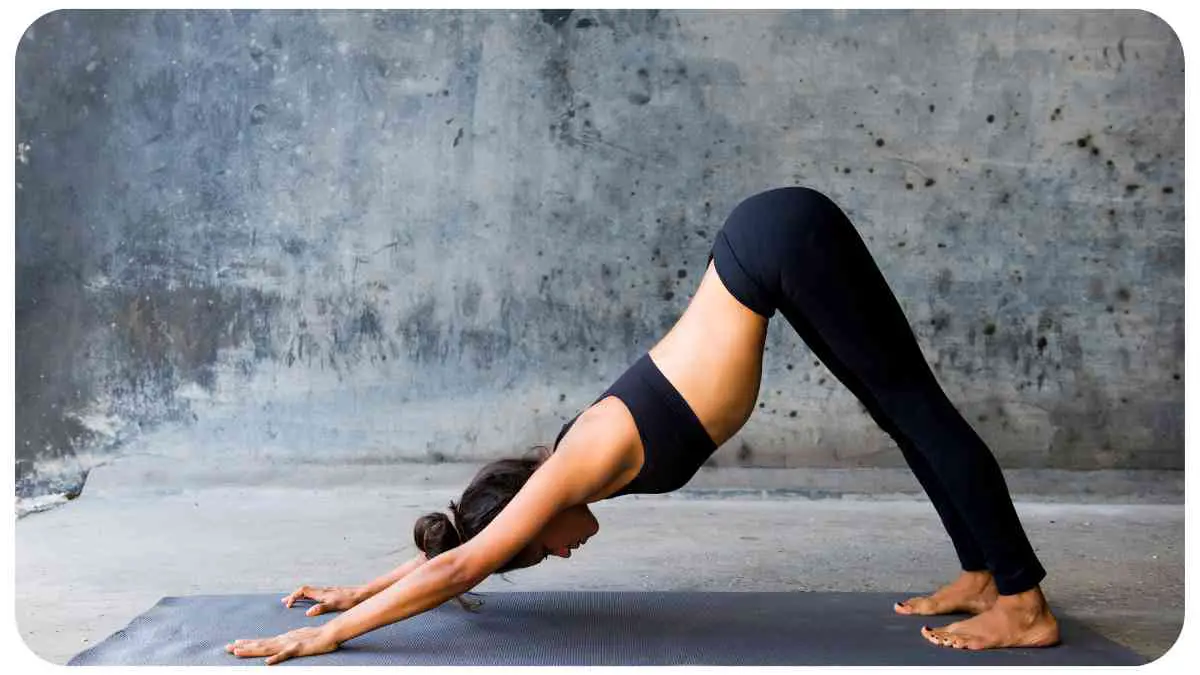Welcome to our guide on fixing your Downward Dog Pose! Downward Dog, also known as Adho Mukha Svanasana in Sanskrit, is a foundational yoga pose that offers numerous physical and mental benefits. However, many practitioners struggle with maintaining proper alignment and engaging the right muscles, which can lead to discomfort or reduced effectiveness of the pose.
In this article, we will delve into troubleshooting tips that will help you improve your Downward Dog Pose. Drawing from our own experiences and expertise as yoga professionals, we’ll guide you through common mistakes and provide practical advice to enhance your practice. So let’s dive in and fix those alignment issues!
| Takeaway |
|---|
| Proper alignment is crucial in Downward Dog Pose to ensure effectiveness. |
| Engage your core and activate the right muscles for stability and strength. |
| Modifications and props can assist in achieving proper alignment and support. |
| Breathing mindfully enhances the flow and relaxation in Downward Dog Pose. |
| Practice warm-up exercises and build strength to prepare for the pose. |
| Advanced variations and transitions add challenge and depth to your practice. |
| Focus on core engagement and stability to enhance the pose’s benefits. |
| Explore further resources to deepen your understanding and refine your practice. |
2. Understanding the Downward Dog Pose
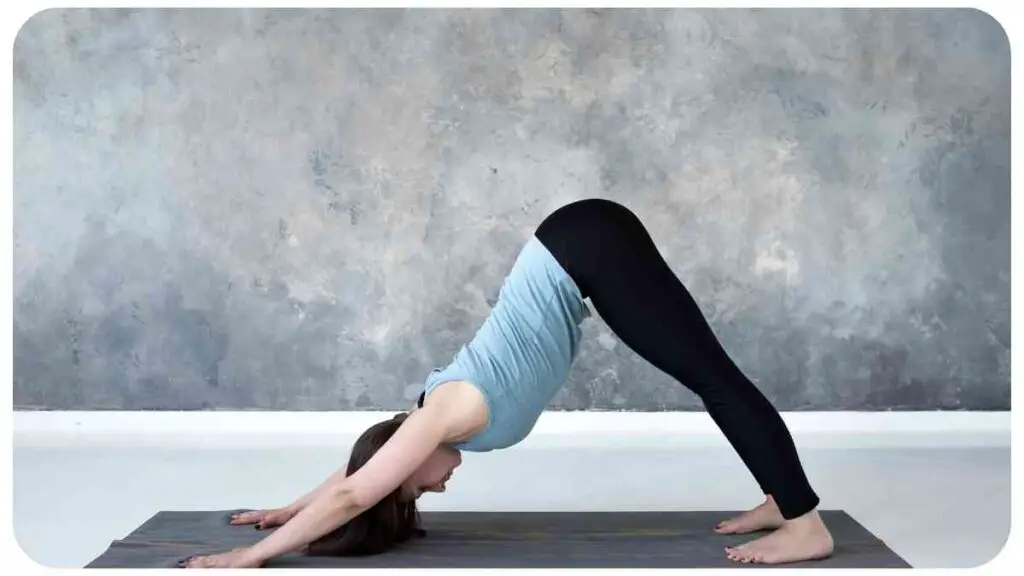
Before we delve into troubleshooting tips, let’s take a moment to understand the Downward Dog Pose and its benefits. This pose is an integral part of most yoga sequences and serves as a transition pose between different asanas (poses). It strengthens and stretches the entire body, providing a wonderful combination of relaxation and energization.
Building a solid foundation in your yoga practice goes beyond the physical postures. Explore the deeper meaning of your practice and connect with your inner self to truly elevate your yoga experience.
2.1 Benefits of Downward Dog Pose
Table: Benefits of Downward Dog Pose
| Benefit | Description |
| Strengthens the upper body | Downward Dog Pose builds strength in the arms, shoulders, and upper back. |
| Stretches the hamstrings | The pose elongates and loosens the hamstrings, reducing tightness and increasing flexibility. |
| Lengthens the spine | Practicing Downward Dog Pose helps decompress the spine and promote good posture. |
| Energizes and rejuvenates | The pose improves blood circulation, providing a burst of energy and revitalization. |
| Relieves stress and calms the mind | Downward Dog Pose promotes relaxation, relieves anxiety, and helps clear the mind. |
2.2 Common Mistakes in Downward Dog Pose
Table: Common Mistakes in Downward Dog Pose
| Mistake | Description |
| Rounded or sagging back | A common mistake is allowing the back to round or sag, which reduces the effectiveness of the pose. |
| Collapsed shoulders and lack of engagement | Many practitioners forget to engage the shoulders, leading to improper alignment and less stability. |
| Tight hips and lifted heels | Some individuals struggle with tight hips and consequently lift their heels off the ground. |
| Overarching or hyperextending the spine | Hyperextending the spine can strain the lower back and compromise the pose’s benefits. |
| Incorrect hand and foot positioning | Placing the hands too far forward or having the feet too close together can affect stability. |
Now that we have a better understanding of the pose and its potential pitfalls, let’s move on to troubleshooting tips that will help you fix and improve your Downward Dog Pose.
Enhancing athletic performance is not limited to traditional training methods. Discover the surprising benefits of incorporating yoga into your routine and unlock new levels of strength, flexibility, and focus.
3. Troubleshooting Tips for Downward Dog Pose
3.1 Alignment Issues
One of the most important aspects of the Downward Dog Pose is maintaining proper alignment. Here are some tips to ensure you’re aligning your body correctly:
- Start with your hands shoulder-width apart and your fingers spread wide, pressing firmly into the mat. This will create a strong foundation.
- Engage your core muscles and lift your sitting bones upward, lengthening your spine. Avoid rounding or sagging in the back.
- Keep your neck relaxed and in line with your spine. Avoid straining or looking up too much.
Table: Alignment Tips for Downward Dog Pose
| Alignment Issue | Troubleshooting Tip |
| Rounded back | Engage your core muscles, lift your sitting bones, and lengthen your spine to avoid rounding the back. |
| Collapsed shoulders | Draw your shoulder blades down and engage the muscles around your shoulder girdle for stability. |
| Neck strain | Keep your neck relaxed and aligned with your spine. Avoid straining or looking up excessively. |
3.2 Shoulder and Arm Engagement
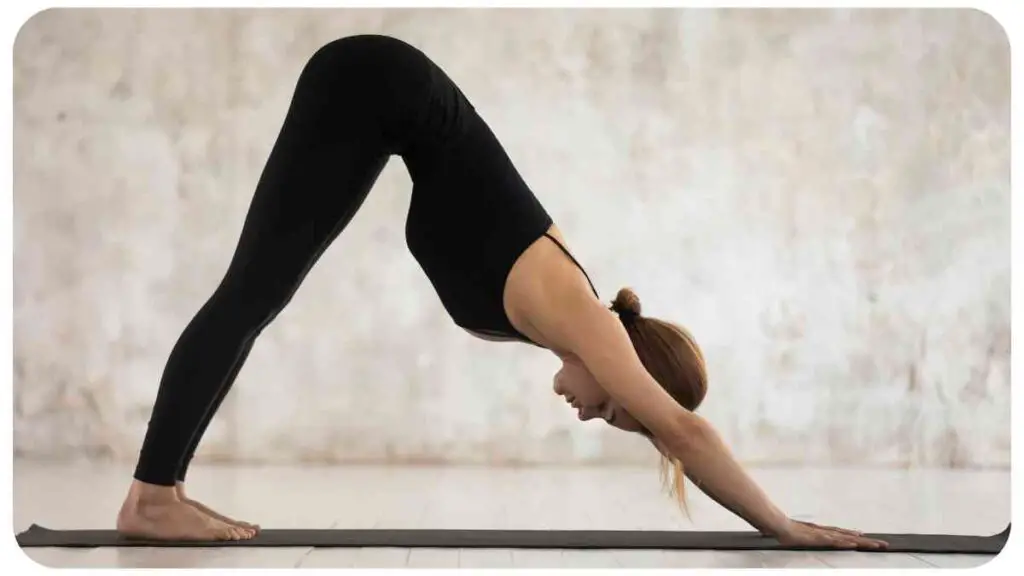
Proper engagement of the shoulders and arms is crucial for a strong and stable Downward Dog Pose. Follow these tips to ensure you’re activating the right muscles:
- Press firmly through your hands and fingers, distributing the weight evenly.
- Draw your shoulder blades down your back and away from your ears.
- Engage your triceps by actively pressing your upper arms toward each other.
- Imagine creating space between your shoulder blades, allowing for greater stability and openness in the upper body.
Table: Tips for Shoulder and Arm Engagement in Downward Dog Pose
| Shoulder and Arm Engagement | Troubleshooting Tip |
| Hand placement | Ensure your hands are shoulder-width apart and press firmly into the mat, distributing weight evenly. |
| Shoulder blade position | Draw your shoulder blades down your back and away from your ears to avoid collapsing and promote stability. |
| Engaging the triceps | Actively press your upper arms toward each other, engaging the triceps and creating strength in the upper body. |
3.3 Hip Positioning
Correct alignment and positioning of the hips are essential for a balanced Downward Dog Pose. Consider the following tips:
- Start with your feet hip-width apart and parallel to each other.
- Root through your heels and press them toward the mat, while simultaneously lengthening through your tailbone.
- Avoid lifting the heels or sinking into the hips. Find a neutral position where the hips are neither too high nor too low.
Table: Tips for Hip Positioning in Downward Dog Pose
| Hip Positioning | Troubleshooting Tip |
| Feet placement | Position your feet hip-width apart and parallel to each other to create a solid foundation. |
| Rooting through | Press your heels toward the mat to engage the leg muscles and create stability. Avoid lifting the heels or sinking into the hips. |
| Finding neutral | Aim for a neutral position where the hips are neither too high nor too low. |
3.4 Leg Alignment and Stability
Proper leg alignment and stability contribute to the overall strength and effectiveness of the pose. Follow these tips for optimal leg positioning:
- Activate your quadriceps by lifting your kneecaps and engaging the front of your thighs.
- Press firmly through the inner and outer edges of your feet, distributing the weight evenly.
- Keep your legs straight without locking the knees. Find a balance between strength and softness in the legs.
Is back pain hindering your yoga practice? Say goodbye to discomfort with a series of targeted yoga poses. Explore our guide on relieving back pain with these recommended yoga poses to bring balance and harmony back to your body.
Table: Tips for Leg Alignment and Stability in Downward Dog Pose
| Leg Alignment and Stability | Troubleshooting Tip |
| Engaging the quadriceps | Lift your kneecaps and engage the front of your thighs to activate the quadriceps and create stability in the legs. |
| Foot placement | Press firmly through the inner and outer edges of your feet, distributing the weight evenly and finding balance in the pose. |
| Avoiding locked knees | Keep your legs straight without hyperextending or locking the knees. Find a balance between strength and softness in the legs. |
3.5 Modifications and Props
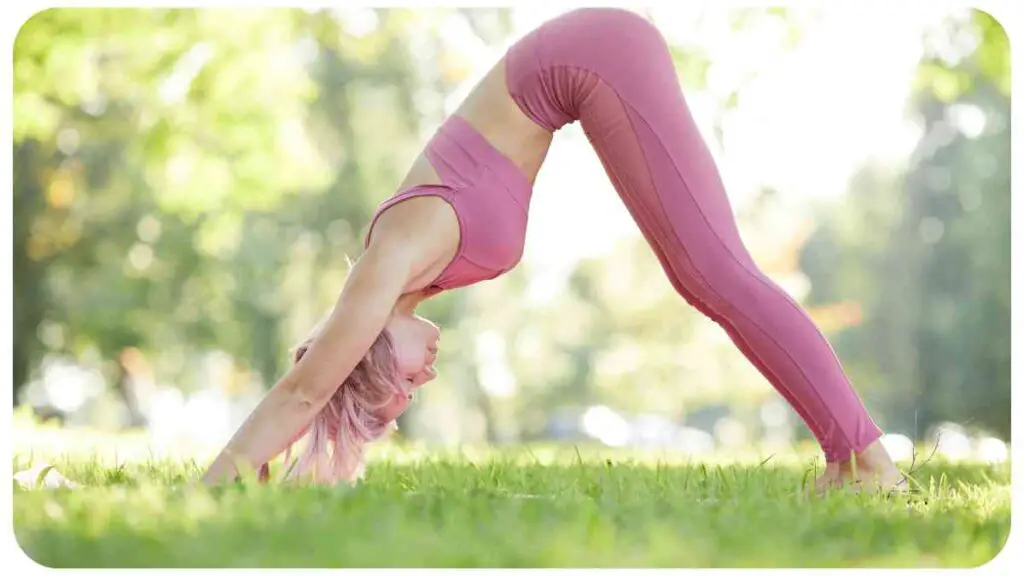
If you’re experiencing difficulty in achieving proper alignment or need extra support, modifications and props can be helpful. Consider the following options:
- Use a yoga block under your hands to bring the ground closer if reaching the floor is challenging.
- Place a folded blanket under your heels if you struggle with tight calves or find it difficult to keep the heels grounded.
- Utilize a strap around your upper arms to help maintain shoulder alignment and engage the muscles effectively.
Table: Modifications and Props for Downward Dog Pose
| Modifications and Props | Troubleshooting Tip |
| Yoga block | Use a block under your hands to bring the ground closer if reaching the floor is challenging. |
| Folded blanket | Place a folded blanket under your heels to support tight calves or maintain contact with the ground. |
| Yoga strap | Utilize a strap around your upper arms to help maintain shoulder alignment and engage the muscles effectively. |
4. Proper Breathing Techniques
Incorporating proper breathing techniques into your Downward Dog Pose can enhance your practice and deepen your experience. Here are some tips to help you synchronize your breath:
- Breathe deeply and evenly, using the full capacity of your lungs.
- Inhale as you prepare to transition into Downward Dog Pose, and exhale as you settle into the pose.
- Focus on lengthening your breath, allowing it to guide the flow of movement and relaxation in the pose.
Table: Breathing Tips for Downward Dog Pose
| Breathing Technique | Troubleshooting Tip |
| Deep and even | Breathe deeply and evenly, using the full capacity of your lungs to promote relaxation and focus. |
| Inhale and exhale | Inhale as you prepare to transition into Downward Dog Pose, and exhale as you settle into the pose. |
| Lengthening the | Focus on lengthening your breath, allowing it to guide the flow of movement and relaxation in the pose. |
5. Incorporating Downward Dog Pose into Your Yoga Practice
Now that you’ve learned troubleshooting tips for Downward Dog Pose, let’s explore how to incorporate it effectively into your yoga practice. Here’s a step-by-step guide:
Searching for an effective way to shed some extra pounds? Look no further than yoga. Delve into the world of yoga for weight loss with our ultimate guide, and discover how this ancient practice can transform your body and support your weight management journey.
5.1 Warm-up Exercises
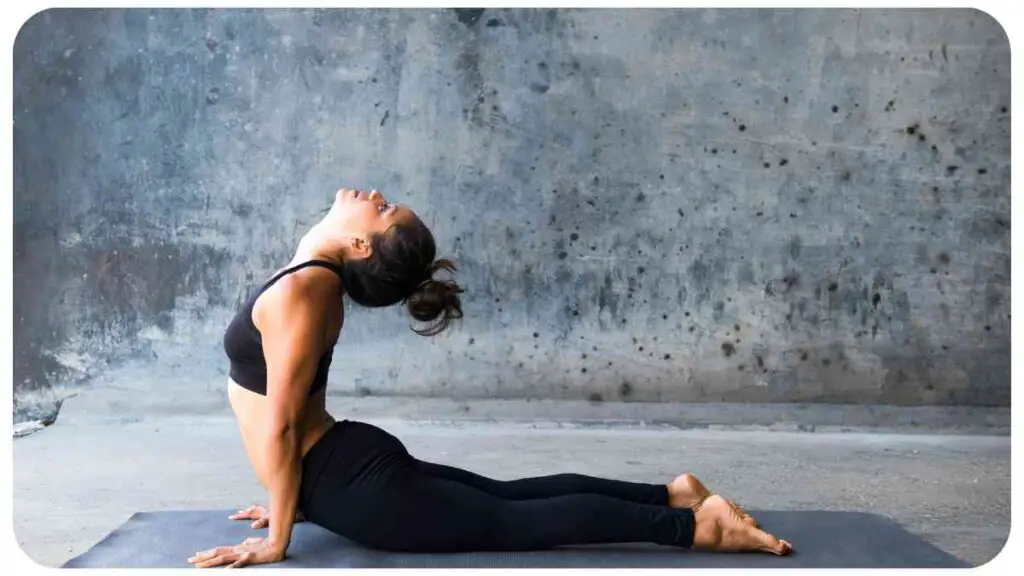
Before practicing Downward Dog Pose, it’s essential to warm up your body. Consider these warm-up exercises:
- Cat-Cow Pose: Begin on all fours, inhaling as you arch your back and lift your chest (Cow Pose), and exhaling as you round your back and tuck your chin to your chest (Cat Pose). Repeat for several rounds, syncing your breath with movement.
- Child’s Pose: From a kneeling position, lower your hips onto your heels and extend your arms forward, resting your forehead on the mat. Take a few deep breaths to relax and prepare your body.
5.2 Building Strength and Flexibility
To enhance your Downward Dog Pose, it’s beneficial to work on strength and flexibility in specific areas. Consider these exercises:
- Plank Pose: Start in a push-up position, with your hands directly under your shoulders and your body in a straight line. Hold for a few breaths to build strength in your core and upper body.
- Standing Forward Bend: Stand with your feet hip-width apart, exhale, and fold forward from your hips, reaching your hands towards the ground. This pose helps stretch the hamstrings and increase flexibility in the spine.
Overcoming obstacles in your yoga practice can be challenging, but with the right troubleshooting techniques, you can find balance and progress. Check out our comprehensive guide on troubleshooting common mistakes to optimize your yoga experience and unlock your full potential.
5.3 Transitioning into Downward Dog Pose
To transition smoothly into Downward Dog Pose, follow these steps:
- From a standing position, exhale and bend forward, bringing your hands to the mat.
- Step one foot back at a time, keeping your hands firmly grounded, and lift your hips to the sky.
- Find your alignment by adjusting your hands, feet, and hips as discussed earlier.
- Take a few breaths in Downward Dog Pose, focusing on your alignment, stability, and breath.
Table: Incorporating Downward Dog Pose into Your Yoga Practice
| Yoga Practice Integration | Troubleshooting Tip |
| Warm-up exercises | Begin with Cat-Cow Pose and Child’s Pose to warm up your body and prepare for Downward Dog Pose. |
| Building strength | Incorporate Plank Pose to build strength in your core and upper body. Add Standing Forward Bend to enhance flexibility. |
| Transitioning into pose | Transition smoothly by bending forward, stepping back one foot at a time, and adjusting alignment as needed. |
6. Advanced Tips for Enhancing Your Downward Dog Pose
Once you’ve mastered the fundamentals of Downward Dog Pose, you can explore advanced techniques to deepen your practice and experience. Here are some tips to take your Downward Dog to the next level:
6.1 Variations for Increased Challenge
Challenge yourself by incorporating these variations into your Downward Dog Pose:
- One-Legged Downward Dog: Lift one leg straight up in the air, engaging your core and maintaining stability. Hold for a few breaths, then switch to the other leg.
- Three-Legged Downward Dog: Similar to the one-legged variation, lift one leg up and extend it to the side, opening your hips. Alternate sides.
- Downward Dog Push-ups: From the standard Downward Dog Pose, shift your weight forward, bending your arms and lowering your head toward the ground. Push back up to the starting position. This variation strengthens the arms and shoulders.
Table: Variations for Increased Challenge in Downward Dog Pose
| Variations | Troubleshooting Tip |
| One-Legged Downward Dog | Engage your core and focus on maintaining stability. |
| Three-Legged Downward Dog | Open your hips and find balance by actively engaging the supporting leg and keeping the shoulders square. |
| Downward Dog Push-ups | Maintain proper alignment and engage the core, arms, and shoulders throughout the movement. |
6.2 Incorporating Transitions and Flow
Flowing between poses adds a dynamic element to your practice. Explore these transitions involving Downward Dog Pose:
- Downward Dog to Plank Pose: From Downward Dog, shift your weight forward, bringing your shoulders over your wrists, and lower into Plank Pose. Then, push back up to Downward Dog. Repeat this sequence to create a fluid flow.
- Downward Dog to Upward Dog/Cobra Pose: From Downward Dog, shift your weight forward, lowering your hips and transitioning into Upward Dog or Cobra Pose. Engage your back muscles and open your chest, then return to Downward Dog.
Table: Transitions and Flow incorporating Downward Dog Pose
| Transitions and Flow | Troubleshooting Tip |
| Downward Dog to Plank Pose | Maintain core engagement and proper alignment as you transition between the two poses. |
| Downward Dog to Upward Dog | Focus on the extension of the spine and opening of the chest in Upward Dog/Cobra Pose. Maintain fluid movement. |
6.3 Core Engagement and Stability
Activating your core muscles can enhance the stability and strength in Downward Dog Pose. Try these techniques:
- Hollow Body Downward Dog: Engage your core by drawing your belly button in towards your spine and lifting your pelvic floor muscles. Imagine creating a hollow space between your belly and your spine.
- Knee-to-Elbow Hover: From Downward Dog, bring one knee towards your opposite elbow, engaging your core and maintaining a hover before extending the leg back. Repeat on the other side.
Table: Core Engagement and Stability in Downward Dog Pose
| Core Engagement and Stability | Troubleshooting Tip |
| Hollow Body Downward Dog | Maintain core engagement by drawing your belly button in towards your spine and lifting your pelvic floor. |
| Knee-to-Elbow Hover | Focus on engaging your core as you bring your knee towards your elbow and hold the hover before extending back. |
6.4 Core Engagement and Stability
Activating your core muscles can enhance the stability and strength in Downward Dog Pose. Try these techniques:
- Hollow Body Downward Dog: Engage your core by drawing your belly button in towards your spine and lifting your pelvic floor muscles. Imagine creating a hollow space between your belly and your spine.
- Knee-to-Elbow Hover: From Downward Dog, bring one knee towards your opposite elbow, engaging your core and maintaining a hover before extending the leg back. Repeat on the other side.
Table: Core Engagement and Stability in Downward Dog Pose
| Core Engagement and Stability | Troubleshooting Tip |
| Hollow Body Downward Dog | Maintain core engagement by drawing your belly button in towards your spine and lifting your pelvic floor. |
| Knee-to-Elbow Hover | Focus on engaging your core as you bring your knee towards your elbow and hold the hover before extending back. |
7. Frequently Asked Questions (FAQs)
Let’s address some common questions related to Downward Dog Pose:
7.1 How long should I hold the Downward Dog Pose?
The duration of holding Downward Dog Pose can vary depending on your practice and comfort level. As a general guideline, aim to hold the pose for about 5 to 10 breaths. However, feel free to adjust the duration based on your own needs and abilities.
7.2 Can Downward Dog Pose help with back pain?
Yes, Downward Dog Pose can be beneficial for relieving back pain. It helps stretch and lengthen the spine, alleviating tension and promoting good posture. However, if you have a specific back condition or chronic pain, it’s essential to consult with a healthcare professional or a qualified yoga instructor for personalized guidance.
7.3 Is Downward Dog Pose suitable for beginners?
Downward Dog Pose is commonly practiced by beginners and experienced yogis alike. It offers an excellent opportunity to build strength, flexibility, and body awareness. However, if you’re new to yoga, it’s helpful to start with modifications and gradually work towards the full expression of the pose. Seek guidance from a qualified instructor to ensure proper alignment and technique.
8. Conclusion
Congratulations on completing this comprehensive guide on fixing your Downward Dog Pose! By incorporating the troubleshooting tips we’ve discussed, you can improve your alignment, engage the right muscles, and deepen your practice.
Remember to prioritize proper alignment, breathe mindfully, and listen to your body. With consistency and patience, you’ll continue to refine and enhance your Downward Dog Pose, reaping its numerous physical and mental benefits.
So, roll out your mat, find your center, and enjoy the journey of perfecting your Downward Dog Pose. Namaste!
Further Reading
Here are some additional resources you can explore to deepen your understanding of Downward Dog Pose:
MasterClass: Downward Dog Explained: This article on MasterClass provides an in-depth explanation of the Downward Dog Pose, including its benefits, alignment tips, and variations.
Tint Yoga: Downward Facing Dog Alignment—Are You Doing It Wrong?: Learn about common alignment mistakes in Downward Dog Pose and how to correct them for a safer and more effective practice.
The Yoga Nomads: Downward Dog: Dive into the world of Downward Dog Pose with this comprehensive guide that covers its benefits, modifications, and techniques to enhance your practice.
Feel free to explore these resources for additional insights, tips, and guidance to further enhance your Downward Dog Pose.
FAQs
Here are some frequently asked questions about Downward Dog Pose:
Is Downward Dog Pose suitable for beginners?
Yes, Downward Dog Pose is generally suitable for beginners. However, it’s important to practice with proper alignment and listen to your body. If you’re new to yoga or have specific concerns, it’s recommended to seek guidance from a qualified instructor.
How long should I hold Downward Dog Pose?
The duration of holding Downward Dog Pose can vary based on your practice and comfort level. As a general guideline, aim to hold the pose for 5 to 10 breaths. Gradually increase the duration as you build strength and flexibility.
Can Downward Dog Pose help with back pain?
Yes, Downward Dog Pose can be beneficial for relieving back pain. The pose stretches and lengthens the spine, promoting good posture and alleviating tension. However, if you have a specific back condition or chronic pain, consult with a healthcare professional or a qualified yoga instructor for personalized guidance.
How can I modify Downward Dog Pose if I have tight hamstrings?
If you have tight hamstrings, you can modify Downward Dog Pose by slightly bending your knees. This modification helps to alleviate strain on the hamstrings and allows you to focus on maintaining proper alignment and engagement in other parts of the body.
Can Downward Dog Pose be practiced during pregnancy?
Downward Dog Pose can be practiced during pregnancy with modifications. It’s important to consult with a prenatal yoga instructor who can guide you on proper alignment, modifications, and considerations for practicing Downward Dog Pose safely during pregnancy.
These FAQs provide answers to common questions about Downward Dog Pose, but always remember to listen to your body, respect your limitations, and consult with a qualified professional if you have any specific concerns or conditions.

Hello, my name is Hellen James! I am a yoga teacher and writer who loves to share information about how you can achieve a more fulfilling life. I have been practicing mindfulness, yoga, and meditation for over 10 years. My passion for these practices has led me to teach them to others.

